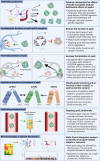ApoE in Alzheimer's disease: pathophysiology and therapeutic strategies
- PMID: 36348357
- PMCID: PMC9644639
- DOI: 10.1186/s13024-022-00574-4
ApoE in Alzheimer's disease: pathophysiology and therapeutic strategies
Abstract
Alzheimer's disease (AD) is the most common cause of dementia worldwide, and its prevalence is rapidly increasing due to extended lifespans. Among the increasing number of genetic risk factors identified, the apolipoprotein E (APOE) gene remains the strongest and most prevalent, impacting more than half of all AD cases. While the ε4 allele of the APOE gene significantly increases AD risk, the ε2 allele is protective relative to the common ε3 allele. These gene alleles encode three apoE protein isoforms that differ at two amino acid positions. The primary physiological function of apoE is to mediate lipid transport in the brain and periphery; however, additional functions of apoE in diverse biological functions have been recognized. Pathogenically, apoE seeds amyloid-β (Aβ) plaques in the brain with apoE4 driving earlier and more abundant amyloids. ApoE isoforms also have differential effects on multiple Aβ-related or Aβ-independent pathways. The complexity of apoE biology and pathobiology presents challenges to designing effective apoE-targeted therapeutic strategies. This review examines the key pathobiological pathways of apoE and related targeting strategies with a specific focus on the latest technological advances and tools.
© 2022. The Author(s).
Conflict of interest statement
GB consults for SciNeuro and Lexeo, has consulted for AbbVie, E-Scape, Eisai, and Vida Ventures, and is on the scientific advisory board for Kisbee Therapeutics. All other authors declare no competing interests.
Figures



References
Publication types
MeSH terms
Substances
Grants and funding
LinkOut - more resources
Full Text Sources
Medical
Miscellaneous

